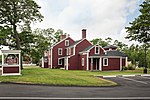Santuit Post Office
Barnstable County, Massachusetts Registered Historic Place stubsBuildings and structures in Barnstable, MassachusettsNational Register of Historic Places in Barnstable, MassachusettsPost office buildings on the National Register of Historic Places in Massachusetts

The Santuit Post Office is a historic post office building on Main Street in the Santuit village of Barnstable, Massachusetts. The 1+1⁄2-story wood-frame cottage was built c. 1846, and exhibits simple Gothic Revival styling reminiscent of seaside cottages that were constructed in the area between 1850 and 1875. The building served as a post office for Santuit village until the 1970s, when it was converted into a private residence.The building was listed on the National Register of Historic Places in 1987.
Excerpt from the Wikipedia article Santuit Post Office (License: CC BY-SA 3.0, Authors, Images).Santuit Post Office
Schooner Drive,
Geographical coordinates (GPS) Address Nearby Places Show on map
Geographical coordinates (GPS)
| Latitude | Longitude |
|---|---|
| N 41.635 ° | E -70.450277777778 ° |
Address
Schooner Drive 29
02635 , Cotuit (Barnstable)
Massachusetts, United States
Open on Google Maps











